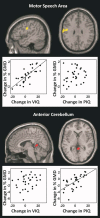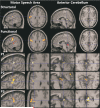Verbal and non-verbal intelligence changes in the teenage brain
- PMID: 22012265
- PMCID: PMC3672949
- DOI: 10.1038/nature10514
Verbal and non-verbal intelligence changes in the teenage brain
Erratum in
-
Addendum: Verbal and non-verbal intelligence changes in the teenage brain.Nature. 2012 May 16;485(7400):666. doi: 10.1038/nature11113. Nature. 2012. PMID: 22660332 No abstract available.
Abstract
Intelligence quotient (IQ) is a standardized measure of human intellectual capacity that takes into account a wide range of cognitive skills. IQ is generally considered to be stable across the lifespan, with scores at one time point used to predict educational achievement and employment prospects in later years. Neuroimaging allows us to test whether unexpected longitudinal fluctuations in measured IQ are related to brain development. Here we show that verbal and non-verbal IQ can rise or fall in the teenage years, with these changes in performance validated by their close correlation with changes in local brain structure. A combination of structural and functional imaging showed that verbal IQ changed with grey matter in a region that was activated by speech, whereas non-verbal IQ changed with grey matter in a region that was activated by finger movements. By using longitudinal assessments of the same individuals, we obviated the many sources of variation in brain structure that confound cross-sectional studies. This allowed us to dissociate neural markers for the two types of IQ and to show that general verbal and non-verbal abilities are closely linked to the sensorimotor skills involved in learning. More generally, our results emphasize the possibility that an individual's intellectual capacity relative to their peers can decrease or increase in the teenage years. This would be encouraging to those whose intellectual potential may improve, and would be a warning that early achievers may not maintain their potential.
Figures


References
-
- McCall RB. Childhood IQ’s as predictors of adult educational and occupational status. Science. 1977;197:482–483. - PubMed
-
- Deary IJ, Whalley LJ, Lemmon H, Crawford JR, Starr JM. The stability of differences in mental ability from childhood to old age: follow-up of the 1932 Scottish Mental Survey. Intelligence. 2000;28(1):49–55.
-
- Wilke M, Sohn J-H, Byars AW, Holland SK. Bright spots: correlations of gray matter volume with IQ in a normal pediatric population. NeuroImage. 2003;20:202–215. - PubMed
-
- Gong Q-Y, et al. Voxel_based morphometry and stereology provide convergent evidence of the importance of medial prefrontal cortex for fluid intelligence in healthy adults. NeuroImage. 2005;25:1175–1186. - PubMed
-
- Camara WJ, Nathan JS, Puente AE. Psychological test usage: implications in professional psychology. Professional Psychology: Research and Practice. 2000;31(2):141–154.
Publication types
MeSH terms
Grants and funding
LinkOut - more resources
Full Text Sources

